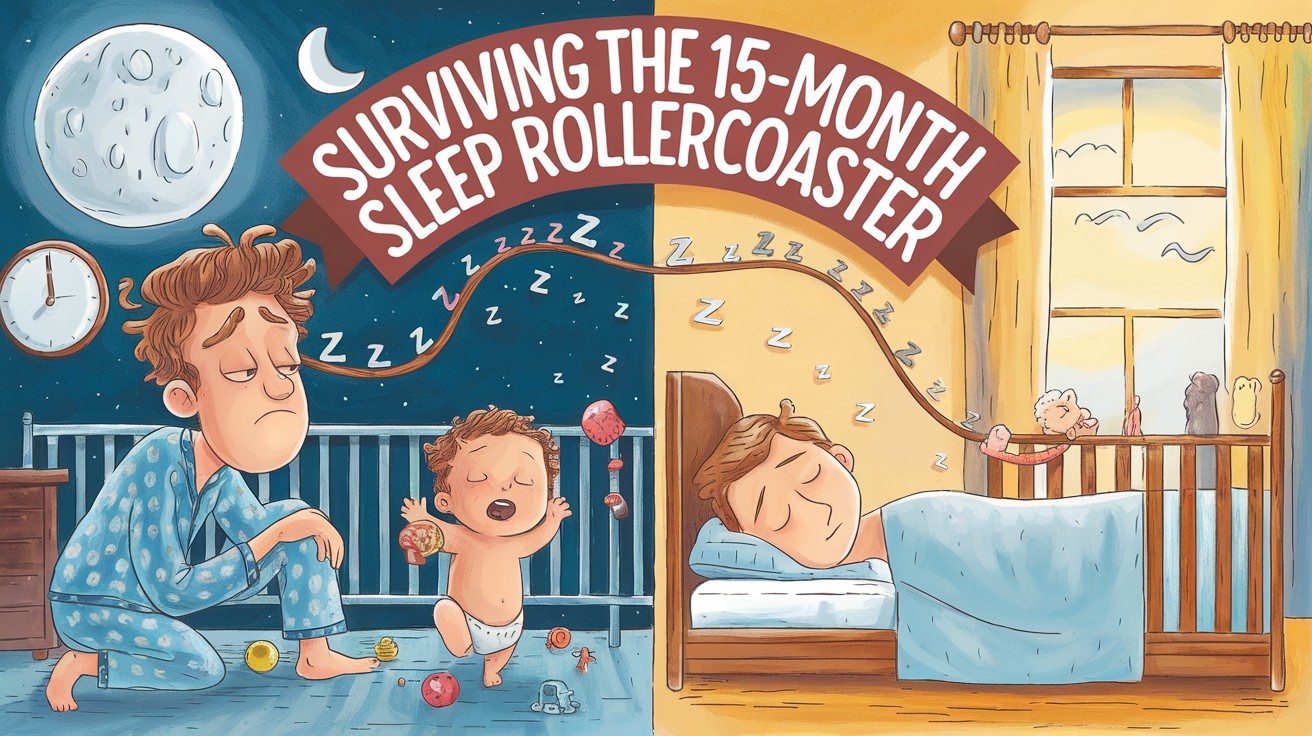
When you thought you’d finally mastered your toddler’s sleep routine, the 15-month sleep regression arrives like an unexpected thunderstorm!
This challenging phase typically appears when your little one resists naps, wakes frequently at night, or battles bedtime with newfound determination.
Rest assured, you’re not alone. This regression is a common developmental hurdle affecting many toddlers between 14 and 18 months. While frustrating, it’s usually temporary, lasting 2-6 weeks for most families.
Did you know that toddlers spend about 11-14 hours sleeping daily, compared to newborns’ 16-17 hours?
Behind the scenes, remarkable development is happening. Your toddler is mastering walking, experiencing language explosions, and developing independence—all milestones that can disrupt established sleep patterns as their active minds process these exciting new skills.
The 15-Month Sleep Regression
The 15-month sleep regression is a temporary period when toddlers who previously slept well suddenly experience disruptions in their sleep patterns.
This regression typically coincides with significant developmental milestones—walking confidently, language explosion, and newfound independence.
These cognitive and physical leaps can overwhelm a toddler’s developing brain, making it difficult to settle down at night.
Unlike persistent sleep problems, a regression is temporary, usually lasting 2-4 weeks. Increased night-waking, bedtime resistance, shortened naps, and early morning wake-ups characterize it.
Parents can guide this challenging phase by maintaining consistent bedtime routines, offering extra daytime reassurance, and understanding that this disruption, while frustrating, signals healthy development and will pass with time and patience.
Common Signs of the 15 Month Sleep Regression

The 15-month sleep regression often manifests through several recognizable patterns. Babies typically struggle to fall asleep and fight bedtime even when clearly tired.
Increased night-wakings become more frequent, with little ones who previously slept through now waking multiple times and needing comfort.
Nap disruptions are equally common, with shorter daytime sleep or complete nap refusal despite obvious fatigue.
Parents may notice increased fussiness or clinginess, specifically around bedtime routines. Babies become more dependent on parental presence to settle. These changes often coincide with developmental milestones like walking or language expansion, when babies’ brains are processing new skills.
Most common sign: sudden changes in a previously consistent sleep pattern.
15 Month Sleep Regression: Key Causes
The 15-month sleep regression often surprises parents, disrupting previously established sleep patterns. This challenging phase typically stems from significant developmental milestones your toddler is achieving.
As your little one masters walking and expands their vocabulary, their brain remains active during sleep, processing these new skills. This cognitive overload can lead to night-waking and resistance at bedtime.
Separation anxiety peaks around this age, making your toddler reluctant to be apart from you—especially at night. Their growing independence during the day paradoxically increases their need for reassurance during vulnerable sleep times.
Teething molars can cause significant discomfort, disrupting sleep patterns. Additionally, your toddler may be transitioning from two naps to one, creating temporary sleep disruptions as their body adjusts to new rhythms.
The 15-Month Sleep Regression: Duration and Factors

When you think your toddler’s sleep patterns are established, the 15-month sleep regression arrives to challenge both parent and child. This temporary disruption, while frustrating, is actually a positive sign of your little one’s developmental progress.
Typical Duration (2 to 6 Weeks)
What to Expect: The 15-month sleep regression typically lasts between 2 to 6 weeks. During this period, your previously good sleeper may suddenly fight bedtime, wake frequently at night, or take shorter naps.
This regression coincides with significant developmental milestones as your toddler’s brain and body experience rapid growth.
Many parents notice their little ones practicing new skills like walking or talking even when they should be sleeping.
Signs It’s Ending: You’ll know the regression is ending when your toddler begins returning to normal sleep patterns. Bedtimes will become less of a battle, night-wakings will decrease, and nap schedules will become more predictable again.
Factors That Can Make It Shorter or Longer
Consistency in Routine: Maintaining a consistent bedtime routine can significantly shorten the regression period. Children thrive on predictability, especially during developmental leaps.
A steady routine signals to your toddler’s brain that it’s time to wind down, making the transition to sleep easier despite the developmental changes happening.
Environmental Factors: Changes in your home environment, travel, illness, or major life transitions can extend sleep regression. Your toddler’s developing brain is particularly sensitive to disruptions during this time.
Creating a calm, comfortable sleep space and minimizing changes to their environment when possible can help shorten the regression’s duration.
Tips to Handle the 15 Month Sleep Regression

The 15-month sleep regression often surprises parents just when sleep patterns seem established.
This challenging phase typically coincides with significant developmental milestones as toddlers master walking, talking, and asserting independence.
Maintaining a consistent bedtime routine signals to your toddler that sleep time is approaching. To help them wind down naturally, include calming activities like reading, gentle music, or a warm bath.
When your toddler wakes during the night, offer reassurance without creating dependencies.
A quick check-in with minimal stimulation helps them self-soothe back to sleep. Adjust nap schedules gradually as your toddler’s sleep needs evolve. Watch for signs that your toddler might be ready to transition from two naps to one.
Create a sleep sanctuary with blackout curtains, white noise, and comfortable temperature to minimize disruptions during light sleep cycles.
Special tip: Try the “silent return” method—calmly returning your toddler to bed without conversation when they get up, reinforcing boundaries while providing security.
When to Adjust Your Baby’s Sleep Schedule?

Babies typically transition from multiple naps to just one nap between 12 and 18 months. Watch for signs that your little one is ready: consistently fighting the second nap, taking longer to fall asleep, or waking up early from naps.
Before regression, most babies follow a two-nap schedule with morning and afternoon rest periods.
A typical pre-transition day might include a 9:30 a.m. nap and a 2:00 p.m. nap.
After transitioning, the single midday nap (usually around 12:00 p.m.) becomes longer—often 2-3 hours—to compensate for eliminated sleep periods.
The transition period can be challenging. Try gradually shifting nap times by 15-minute increments until you reach the desired schedule. Maintain consistent wake-up times and bedtimes to help your baby adjust smoothly.
When to Talk to a Pediatrician?

While temporary regression in children’s behavior is normal during developmental stages or stressful periods, consult a pediatrician if regression persists beyond 6 weeks.
This timeline allows for natural adjustment but recognizes when professional guidance may be needed.
Contact your child’s doctor if you notice signs of sleep disorders, such as consistent difficulty falling asleep, frequent night-waking, snoring, or breathing pauses during sleep. These could indicate underlying health concerns requiring medical attention.
Also, seek professional advice if regression coincides with physical symptoms like unexplained weight changes, frequent headaches, digestive issues, or changes in appetite.
Behavioral regression accompanied by significant emotional changes—extreme anxiety, withdrawal, aggression, or mood swings—warrants a conversation with your pediatrician to rule out possible underlying causes and develop appropriate support strategies.
Wrapping It Up
The 15-month sleep regression is a completely normal developmental phase that many parents face.
While it can be exhausting to deal with sudden sleep disruptions, remember that this stage is temporary and actually signals your toddler’s growing brain and body.
Stay consistent with your bedtime routines and sleep boundaries during this challenging period. Your patience and understanding now will help your little one guide this transition more smoothly.
With time and consistency, your toddler will adapt to their new developmental abilities, and sleep patterns will gradually improve.
Before you know it, you’ll both be enjoying more restful nights again, and a more independent and confident little person will emerge from this regression.
If you’re interested in more informational content on mothers and babies, feel free to click here and explore other blogs that you might enjoy.
